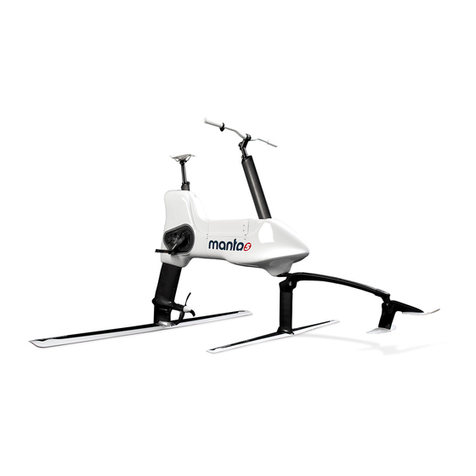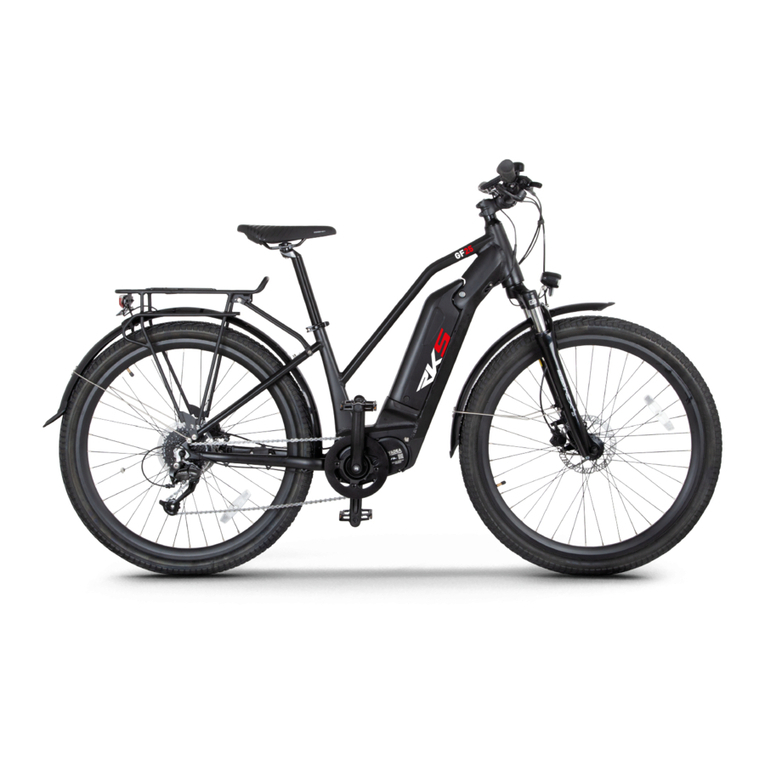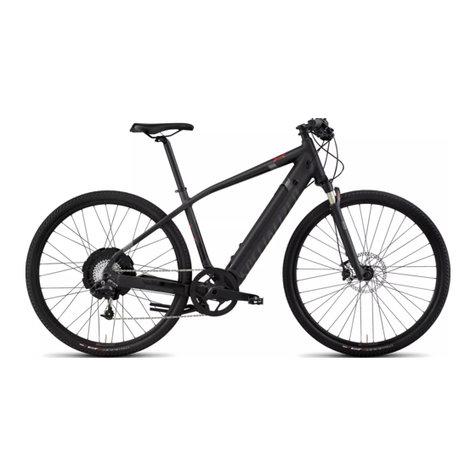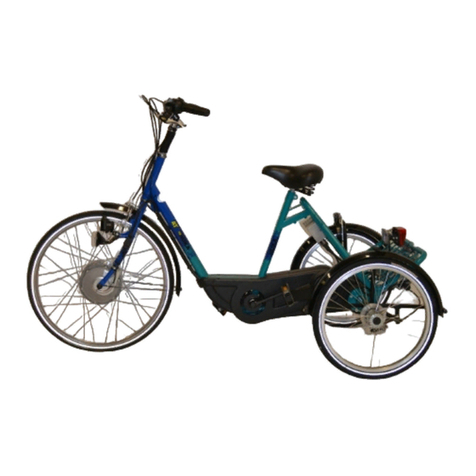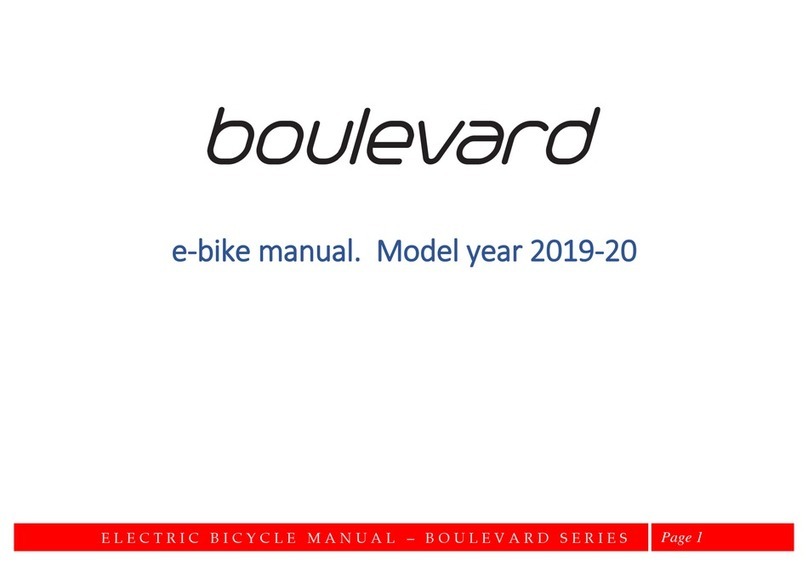Fezzari Simbi User manual

Warning: Please read this entire manual before riding your Simbi.
Failure to do so could result in serious injury or even death.

Contents
1. OVERVIEW ....................................................................................................................................... 3
A. Thank You ....................................................................................................................................... 3
B. General Warning .............................................................................................................................. 3
C. Important Symbols and Terms ........................................................................................................... 4
D. Related Manuals ............................................................................................................................... 4
2. UNPACKING ..................................................................................................................................... 5
A. Box Contents ................................................................................................................................... 5
B. Initial Inspection .............................................................................................................................. 5
C. Registration ..................................................................................................................................... 8
3. ASSEMBLY ........................................................................................................................................ 9
A. Quick Assembly Overview.................................................................................................................. 9
B. Step 1 - Attach Front Wheel..............................................................................................................10
C. Step 2 - Attach Handlebar ................................................................................................................12
D. Step 3 - Attach Pedals......................................................................................................................14
E. Step 4 - Inflate Tires........................................................................................................................16
F. Step 5 - Attach Seat ........................................................................................................................17
G. Step 6 - Attach Additional Reflectors..................................................................................................20
4. OPERATION.................................................................................................................................... 21
A. Before Riding –Important Safety Information .....................................................................................21
5. MAINTENANCE ............................................................................................................................... 23
A. Inspecting ......................................................................................................................................23
B. Brake Adjustments ..........................................................................................................................23
C. Gears.............................................................................................................................................25
D. Pedals............................................................................................................................................25
E. Wheels...........................................................................................................................................26
F. Lubrication .....................................................................................................................................26

G. Cleaning.........................................................................................................................................27
H. Storage..........................................................................................................................................27
I. Baby your Simbi..............................................................................................................................28
6. SIMBI LIMITED WARRANTY ........................................................................................................... 29
A. Warranty Information ......................................................................................................................29
7. TORQUE MEASUREMENT TABLES .................................................................................................... 30
A. Technical Torque Measurements........................................................................................................30
8. SUPPORT........................................................................................................................................ 32
A. Simbi Contact Information................................................................................................................32
9. INDEX ............................................................................................................................................ 33
10. TABLE OF FIGURES......................................................................................................................... 34
11. INDEX OF TABLES .......................................................................................................................... 35

1 - Overview
3
1. OVERVIEW
A. Thank You
Thank you for purchasing a Simbi Bicycle by Fezzari®.
Simbi bicycles are handmade of the finest components.
Simbi was founded on the premise that discerning
customers will embrace products of superior
performance, quality, and value. We hope you
appreciate your Simbi experience. We want this to be
the most rewarding purchase you have ever made. If
you have any feedback, comments, or questions, we
look forward to hearing from you.
B. General Warning
In order to use and enjoy your Simbi bicycle
safely and to get the best durability and
performance, please read this manual carefully
before riding.
The information contained in this manual is to be
used as a guideline for safe operation and is not
intended to replace any safety rules or laws that
may be in force in your area.
Even if you have ridden a bicycle for years, it is
important for every person to read this manual before
you ride your new bicycle.
New information will be made available on the Simbi
website (www.SimbiBicycles.com) as it is available.
Assembly and adjustments of your Simbi take special
tools and skills, so please read carefully.

1 - Overview
4
C. Important Symbols and Terms
Bicycling can be a hazardous activity even under
the best of circumstances. Properly maintaining
your Simbi is your responsibility and will help
reduce the risk of injury. This manual contains
many symbols, terms, and formatting to call
attention to warnings and cautions.
The Warning sign indicates a
potentially hazardous situation
that, if not avoided, could
result in death or serious
injury.
The Caution sign indicates a
potentially hazardous situation
that, if not avoided, could
result in minor or moderate
injury.
The Note sign indicates text
that provides helpful or other
important information.
BOLD
Bold lettering indicates
important text and points to
note.
Please read and follow all Warnings and Cautions
in this manual.
D. Related Manuals
Some of the Simbi components may have separate
manuals that provide additional information. These
manuals were included with your Simbi or may be
online at www.SimbiBicycles.com. Please read and
follow the information in these manuals.

2- Unpacking
5
2. UNPACKING
A. Box Contents
Following is a list of all packaging contents shipped
with your Simbi:
Simbi Bicycle Frame (with rear wheel
attached)
Saddle and Seatpost
Handlebars
Front Wheel
Box containing:
oPedals (left and right)
oFront Wheel Axle
oTools needed to assemble your Simbi
4mm, 5mm, and 6mm Allen
Wrenches (for installing and
adjusting handlebars, brakes,
and seatpost)
15mm Wrench (for attaching
pedals)
oComponent manuals
oExtra parts
B. Initial Inspection
All major parts are identified in
Figure 1. Please familiarize yourself with these parts
prior to assembling or riding your Simbi. Please check
your Simbi along with the parts and components
thoroughly for any damage that may have been
sustained during shipping. Be careful to avoid
scratching the frame when untying or unpacking the
bicycle and components.
If you find that something is missing or
damaged, please contact the Simbi Customer
Support Team at (888) 833-9927.

2- Unpacking
8
C. Registration
The serial number of your bicycle frame is attached to the underside of the down tube or underneath the bottom
bracket shell (see Figure 2 and Error! Reference source not found.).This information is required for you to register
your bike. We must have this registration before we can process a warranty claim. Please fill out the warranty
registration form online at www.SimbiBicycles.com. Your Simbi must be registered before a warranty claim can be
processed.

3 - Assembly:
9
3. ASSEMBLY
A. Quick Assembly Overview
All references to “left”and “right”in this
manual are relative to riding position on the
bicycle.
Your Simbi comes with tools needed for assembly.
Assembly is generally a 5 or 6 step process (note: you
don’t necessarily need to do these in this order):
Step 1 - Attach Front Wheel
Step 2 - Attach Handlebar
Step 3 - Attach Pedals
Step 4 - Inflate Tires
Step 5 - Attach Seat

3 - Assembly: Step 1 - Attach Front Wheel
11
B. Step 1 - Attach Front Wheel
(1) Loosen axle bolts (See Figure 3). Loosen the
axle bolts so that the fork wheel will install
onto the fork.
Figure 3 –Loosen Axle Bolts
(2) Slide wheel into front fork (See Figure 4).
With the steering fork facing forward (angling
away from bike), insert the wheel between the
fork blades so that it firmly touches the inside
of the fork ends. Make sure that the washers
are next to the nut. There is a matching hole
on the fork for the washer to hook into.
The wheel should be put in so that the tread
direction is forward (usually on the sidewall
there’s an arrow pointing which way the tire
rolls).
Figure 4 –Slide Wheel into Fork

3 - Assembly: Step 1 - Attach Front Wheel
12
(3) Fasten wheel securely in fork (See Figure
5). Tighten the bolts snugly with a wrench.
Figure 5 –Fasten Wheel Securely in Fork
(4) Test for proper installation. Spin the wheel
to make sure that it is centered in the frame.
Pick up the bike, and sharply hit the top of the
tire with the heel of your hand. The wheel
must not come off, be loose, or move from
side to side.
Failure to properly adjust the quick
release mechanism can cause the wheel to wobble
or disengage. This could cause you to lose control
and fall, resulting in serious injury or death.

3 - Assembly: Step 2 - Attach Handlebar
13
C. Step 2 - Attach Handlebar
Attach the handlebar and stem to the frame as shown
below.
(1) Insert the Stem into the frame past the
minimum insertion line and then tighten
the bolt snugly with an Allen wrench (See
Figure 6).
Figure 6 –Attach Handlebars to Frame
The stem’s Minimum Insertion Mark
must not be visible above the top of the headset. If
the stem is extended beyond the Minimum
Insertion Mark the stem may break or damage the
frame, and could cause you to lose control and fall.
(2) Loosen the Handlebar Bolt and rotate the
handlebars upward. Then tighten the
Handlebar Bolt again. (See Figure 7).
Figure 7 –Handlebar Adjustment

3 - Assembly: Step 2 - Attach Handlebar
14
(3) Test for proper installation.
i. Make sure stem is centered over the front
wheel and bolts are tight.
ii. Make sure Handlebar is aligned properly
and Handlebar Bolts are tightened.
iii. Ensure that the front fork and stem will
turn easily and smoothly from side to side
without your handlebar slipping.
If you do not fully understand any of the
above steps or if you think the handlebar is not
tightened properly, please contact the Simbi
Customer Support Team (see page 32).
An insufficiently tightened stem bolt or
handlebar binder bolt, may compromise steering
action, which could cause you to lose control and
fall. Place the front wheel of the bicycle between
your legs and attempt to twist the handlebar/stem
assembly. If you can twist the stem in relation to
the front wheel, turn the handlebars in relation to
the stem, or turn the bar end extensions in relation
to the handlebar, the bolts are insufficiently
tightened.
Loose or damaged handlebar grips or
extensions can cause you to lose control and fall.
Make sure all wires and cables are free
from obstruction and not wrapped around the stem
or front fork.

3 - Assembly: Step 3 - Attach Pedals
15
D. Step 3 - Attach Pedals
The pedals have different threads based on which
crank arm they should be connected to. The pedals are
marked with “L” for left and “R” for right. Left and
right are determined from the riding position on the
bicycle.
Left and Right Pedals are threaded in
opposite directions. Do not try to force the wrong
pedal onto the crank arm as it will strip the
threading.
Each pedal is marked with “L” for Left of
“R” for Right.
Left and right are relative to riding position
on your bike.
An easy way to remember how to tighten
your pedals is to tighten both pedals towards the
front of your bike.
(1) Align the pedal axle with the threaded hole in
its respective crank arm. Secure the pedal in
the crank by hand. The right pedal is installed
by turning the pedal axle clockwise and the left
pedal is installed by turning the pedal axle
counter-clockwise.
(2) After the pedals can no longer be turned by
hand, use the pedal wrench included in your
tool kit and tighten the pedals securely. The
shoulder of each pedal should fit snugly
against the crank arm.
Figure 8 –Pedal Installation

3 - Assembly: Step 4 - Inflate Tires
17
E. Step 4 - Inflate Tires
Check the inflation of the tires. Make sure that the
tires are inflated according to the pressure indicated
on the tire sidewall. Tire pressure should not exceed
what is indicated on the sidewall.
Inflate tires only to the pressure
indicated on the tire sidewalls. Do not over-inflate.
(1) Presta Valve Tire Inflation (See Figure 9).
Figure 9 –Presta Valve Tire Inflation
(2) Schrader Valve Tire Inflation (See Figure
10).
Figure 10 –Schrader Valve Tire Inflation
For best results, use a pump with a built-in
pressure gauge. Check www.SimbiBicycles.com for
high quality pumps and other accessories.

3 - Assembly:
Step 6 - Attach Additional Reflectors
18
F. Step 5 - Attach Seat
i. Seatpost Installation
Install the seat post into the seat tube. To adjust the
seat height:
(1) Insert Seatpost into Seat Tube (see Figure
11). Make sure you insert the seatpost past
the Seatpost Minimum Insertion Mark and
Tighten securely.
Figure 11 –Seatpost Installation
Riding with an improperly tightened
seat post can allow the saddle to turn or move and
cause you to lose control and fall.

3 - Assembly:
Step 6 - Attach Additional Reflectors
19
(2) Adjust Seatpost Height (Recommended)
(See Figure 12). Exact saddle height is largely
a matter of personal preference. Below is a
recommended way to adjust seatpost height.
Figure 12 –Recommended Saddle Height
Adjustment
i. Sit on the saddle in riding position without
shoes while someone holds the bicycle
upright.
ii. Position the crank arms so they are
parallel to the seat tube.
iii. Loosen the seatpost binder bolt, or quick-
release.
iv. Place your heel on the pedal and extend
the seatpost until your leg is straight. For
proper riding position, when wearing shoes
and with the ball of your foot on the pedal,
you should have a slight bend in your
knee.
v. Make sure the minimum insertion mark
(See Figure 11) on the seatpost is not
visible above the bike frame. A minimum
of 2 1/2 inches (64 mm) of seatpost must
remain in the frame.
vi. Re-tighten the seatpost quick-release, or
bolt. For a seatpost binder with a quick-
release lever, the mechanism works the
same as a wheel quick-release. Adjust the
lever tension, and make sure it is in the
closed position (see Figure 5 on page 11).
Table of contents





